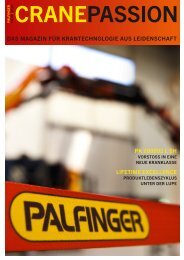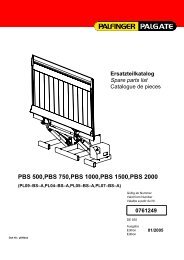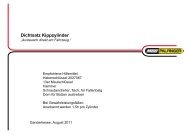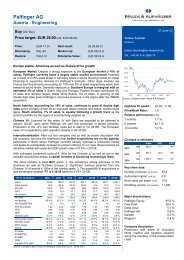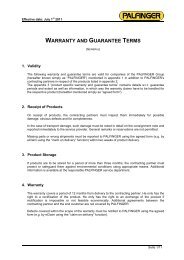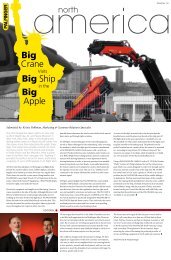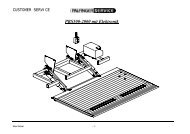palfinger at a glance
palfinger at a glance
palfinger at a glance
You also want an ePaper? Increase the reach of your titles
YUMPU automatically turns print PDFs into web optimized ePapers that Google loves.
search Print<br />
noteS TO THE CONSolid<strong>at</strong>ed FINANCIAL St<strong>at</strong>ementS<br />
conSolid<strong>at</strong>ed FINANCIAL St<strong>at</strong>ementS FOR THE Year ENDED 31 DECEMBER 2011<br />
ACCOUNTING AND VALUATION METHODS<br />
(1) INTANGIBLE ASSetS<br />
Purchased intangible assets are capitalized <strong>at</strong> acquisition cost. Internally gener<strong>at</strong>ed intangible assets are capitalized<br />
<strong>at</strong> manufacturing cost if the preconditions set out in IAS 38 regarding the capitaliz<strong>at</strong>ion of internally gener<strong>at</strong>ed<br />
intangible assets are s<strong>at</strong>isfied.<br />
Intangible assets are subject to amortiz<strong>at</strong>ion over their relevant useful lives. Amortiz<strong>at</strong>ion is performed on a straightline<br />
basis over a time frame between two and fifteen years or in line with the products’ life cycles in the case of<br />
development expenses, and is recorded under the item depreci<strong>at</strong>ion, amortiz<strong>at</strong>ion and impairment expenses.<br />
Customer rel<strong>at</strong>ionships capitalized as part of corpor<strong>at</strong>e acquisitions are amortized over a useful life of five to ten<br />
years. At the end of every financial year the residual values, the useful lives and the methods of amortiz<strong>at</strong>ion of<br />
these assets are reviewed and, if necessary, adjusted prospectively. Changes in the method or period of amortiz<strong>at</strong>ion<br />
th<strong>at</strong> become necessary as a consequence of modific<strong>at</strong>ions of the anticip<strong>at</strong>ed useful lives or the expected consumption<br />
of the future economic benefits of the assets are tre<strong>at</strong>ed as changes in estim<strong>at</strong>es.<br />
In the case of intangible assets with indefinite useful lives and intangible assets under development, each asset<br />
is tested for impairment <strong>at</strong> least once a year. These intangible assets are not amortized over their useful lives on<br />
a system<strong>at</strong>ic basis. Once a year, the useful lives of all intangible assets with indefinite useful lives are checked as<br />
to whether the estim<strong>at</strong>ions of the indefinite useful lives are still justified. If this is not the case, the estim<strong>at</strong>es are<br />
changed prospectively from an indefinite useful life into a finite useful life.<br />
Impairments are recognized in the year in which the event giving rise to the impairment occurs and are recorded<br />
under the item depreci<strong>at</strong>ion, amortiz<strong>at</strong>ion and impairment expenses. If the reasons for the impairment cease to<br />
exist, corresponding reversals of the impairment loss are performed until the level of amortized cost is reached.<br />
Such reversals are recorded as other oper<strong>at</strong>ing income.<br />
Goodwill<br />
Goodwill according to IFRS 3 is not amortized but is instead tested for impairment annually as well as whenever<br />
there are indic<strong>at</strong>ions th<strong>at</strong> impairment has occurred.<br />
In order to perform impairment tests, goodwill is alloc<strong>at</strong>ed to cash-gener<strong>at</strong>ing units. The essential standard<br />
applied for determining whether a unit qualifies as a cash-gener<strong>at</strong>ing unit is the assessment of its technical and<br />
commercial independence in the gener<strong>at</strong>ion of income. The impairment test of the cash-gener<strong>at</strong>ing unit is<br />
carried out by comparing the amortized carrying amount (including the alloc<strong>at</strong>ed goodwill) to the higher of either<br />
the net realizable value or the value in use. The value in use is calcul<strong>at</strong>ed as the present value of relevant future<br />
cash inflows and outflows on the basis of the d<strong>at</strong>a obtained from the internal medium-term corpor<strong>at</strong>e planning.<br />
The discount r<strong>at</strong>e is derived from the Company’s weighted cost of capital. If the calcul<strong>at</strong>ed amount is less than<br />
the carrying amount, the impairment loss in the amount of the difference is alloc<strong>at</strong>ed first to reduce the carrying<br />
amount of the goodwill. Any additional impairment loss is then to be alloc<strong>at</strong>ed to the remaining assets of the<br />
cash-gener<strong>at</strong>ing units in proportion to their carrying amounts.<br />
The impairment test is applied to the entire goodwill capitalized. When, in the course of an acquisition, noncontrolling<br />
interests are reported <strong>at</strong> their fair values, the impairment is spread over the individual groups of shareholders.<br />
The alloc<strong>at</strong>ion is made on the basis of the same key th<strong>at</strong> is also applied when distributing the results of<br />
the subsidiary <strong>at</strong> hand among the shareholders, provided th<strong>at</strong> the subsidiary under review is a cash-gener<strong>at</strong>ing<br />
unit to which goodwill is alloc<strong>at</strong>ed.<br />
According to IFRS 3, goodwill once written down for impairment can no longer be recovered.<br />
<strong>palfinger</strong> Annual Report 2011<br />
123



